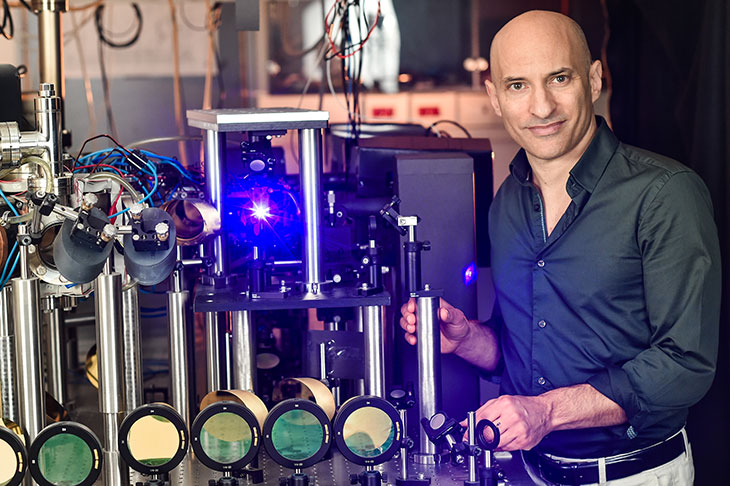
NOT BLACK Stephen Hawking first proposed that black holes (illustrated) aren’t fully black, but emit a faint haze of particles that came to be known as Hawking radiation. Now scientists have measured the radiation’s temperature in a lab analog of a black hole.
NASA’s Goddard Space Flight Center; Background: DPAC/Gaia/ESA
- More than 2 years ago
Taking a black hole’s temperature is a seemingly impossible task. But now, physicists report the next best thing. They’ve measured the temperature of a lab-made sonic black hole, which traps sound instead of light.
If the result holds up, it will confirm a prediction of cosmologist Stephen Hawking, who first proposed a surprising truth about black holes: They aren’t truly black. Instead, a relatively small stream of particles bleeds from each black hole’s margin at a temperature that depends on how massive the black hole is. Such Hawking radiation is too faint to observe in true black holes. But physicists have spotted hints of similar radiation from analogs of black holes created in the lab (SN: 12/18/10, p. 28). In the new study, the sonic black hole’s temperature agrees with that predicted by Hawking’s theory, the team reports in the May 30 Nature.
“It’s a very important milestone,” says physicist Ulf Leonhardt of the Weizmann Institute of Science in Rehovot, Israel, who was not involved with the study. “It’s new in the entire field. Nobody has done such an experiment before.”
To produce the sonic black hole, the researchers used ultracold atoms of rubidium, chilled to a state known as a Bose-Einstein condensate, and set them flowing. Analogous to a black hole’s gravity trapping light, the flowing atoms prevent sound waves from escaping, like a kayaker rowing against a current too strong to overcome. Previous experiments with this setup have shown signs of Hawking radiation, but it wasn’t yet possible to measure its temperature (SN: 11/15/14, p. 14).
Hawking radiation comes from pairs of quantum particles that constantly pop up everywhere, even in empty space. Normally, those particles immediately annihilate one another. But at a black hole’s edge, if one particle falls in, the other could escape, resulting in Hawking radiation. In the sonic black hole, a similar situation occurs: Pairs of sound waves known as phonons can appear, with one falling in and the other escaping.
Measurements of the phonons that escaped and those that fell in allowed the researchers to estimate the temperature, 0.35 billionths of a kelvin. “We found very good agreement with the predictions of Hawking’s theory,” says physicist Jeff Steinhauer of the Technion-Israel Institute of Technology in Haifa.

The result also agrees with Hawking’s prediction that the radiation would be thermal, meaning that the particles’ energies would have a distribution like that of the glow emitted by a warm object, such as the reddish light of a hot electric stove.
After Hawking proposed his theory, this predicted thermal property of the radiation led to a conundrum known as the black hole information paradox. In quantum mechanics, information can never be destroyed. But particles escaping black holes would slowly sap the behemoth’s mass, and over a long period of time, the black hole would shrink into nothingness.
That means that the information that fell into the black hole (in the form of particles, encyclopedias or otherwise) would no longer be contained within it. And if Hawking radiation is thermal, the information couldn’t have been carried away by the fleeing particles. That’s because the emitted particles are indistinguishable from those radiated by a commonplace object with a given temperature, or even by a different black hole of the same mass. That suggests that information can be lost as a black hole evaporates away, a violation of quantum mechanics.
It’s unclear whether the new study could help scientists resolve the information paradox. A solution will probably demand a new theory that combines gravity and quantum mechanics into one new theory of quantum gravity — a task that is one of the biggest outstanding problems in physics. But that theory wouldn’t apply to sonic black holes, since they aren’t created by gravity. “The solution to the information paradox is in the physics of a real black hole, not in the physics of an analog black hole,” Steinhauer says.







